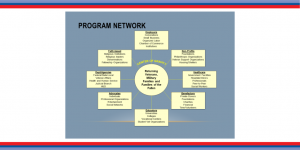Leveraging and Strengthening Program Networks
 In 2012, the Office of the Chairman of the Joint Chiefs of Staff Warrior and Family Support published a White Paper, Channeling the “Sea of Goodwill” to Sustain the “Groundswell of Support” Transitioning from Concept to Application written by Captain Chris Manglicmot, Major Ed Kennedy and Colonel David W. Sutherland, now Chairman of Dixon Center for Military and Veterans Services. The concepts discussed in this white paper, in part, created the concepts, ideas and thoughts enabling the goals and objectives of the Center for Military and Veterans Services (Dixon Center).
In 2012, the Office of the Chairman of the Joint Chiefs of Staff Warrior and Family Support published a White Paper, Channeling the “Sea of Goodwill” to Sustain the “Groundswell of Support” Transitioning from Concept to Application written by Captain Chris Manglicmot, Major Ed Kennedy and Colonel David W. Sutherland, now Chairman of Dixon Center for Military and Veterans Services. The concepts discussed in this white paper, in part, created the concepts, ideas and thoughts enabling the goals and objectives of the Center for Military and Veterans Services (Dixon Center).
One of our goals at Dixon Center is to leverage and strengthen program networks. This concept came from pages 3 in the aforementioned white paper.
“American business, education, healthcare, and community leaders can be better informed of the needs and innovative examples that produce solutions for veteran reintegration and transition. Within communities, connecting ideas and tasks that will have a meaningful impact requires the following: Building public awareness Encouraging community involvement and promoting community-based services.”
This idea resulted in the concept of a Community Action Team (CAT), an organization, that pulls in the various community services to discuss and assess the needs of veterans, families, and families of the fallen, and then develops a plan to meet those needs. The CAT identifies gaps and aligns existing services and programs to increase their impact.
At the Center we have taken this from being geographic to functional. In other words we are focusing on networks that have national reach but local impact reinforcing Dixon Center’s five focus areas: workforce development and career placement; housing solutions; wellness research and development; expanding funding streams for veteran entrepreneurs; and, advancing impact via service networks.
Dixon Center relies upon local, regional, state and national contacts to grow solutions from within communities and through organizations—a must for creating sustained impact and for replicating solutions.
Dixon Center maintains a robust network of diverse players, each of whom helps us achieve our mission in a unique way through their networks. Here are some key findings during the past 12 months, despite the pandemic, we are using to leverage networks to create greater impact in 2021:
- Prioritizing work with networks and building a collaboration model of new solutions, into our strategy for achieving impact
- Building a diverse network with a wide array of expertise, and we are frequently canvassing our network to tap experts who can fill gaps in knowledge, capacity, or resources.
- Nurturing both ground-level partnerships, as well as larger strategic partnerships. The deep knowledge for successful solution implementation can be coupled with extended access to resources.
- Seeking frequent feedback from our networks to gain valuable insight from diverse vantage points. We will be hosting peer shares to drive discussion relating to evolving veteran and military families needs. Then we will act on the results.
- Networks aren’t a panacea, context matters. Just as Government is not a panacea when it comes to veterans and their families, networks help bring diverse groups to the table. Networks need to adapt and find innovative ways to move beyond their silos and involve stakeholders without overtaxing them. This includes constantly asking, “Who else should be included?”
As we move into 2021, we are looking closer at the systemic impacts of COVID-19 which are widespread when considering veterans and their families. Here are just a few…
- As evictions rise, the homelessness rate is expected to rise dramatically while shelters are full.
- Mental health experts are concerned about the long-term impacts from isolation, for example increasing loneliness and death by suicide.
- As voluntary extensions of service members staying in the military through the duration of the pandemic come to an end there could be a surge of transitioning service members who might be entering a rough economy.
2020 has challenged us all to rethink systems and how every organization can integrate veterans into their organization, direct-services, and programs. Dixon Center will continue to leverage and strengthen program networks. In the coming months we will continue our collaborative innovation. We will double down on this process in which multiple players (within and outside our existing national network of community-based programs) contribute towards creating and developing new products, services, policies, processes, or business solutions leading to veterans and their succeeding where they live.

